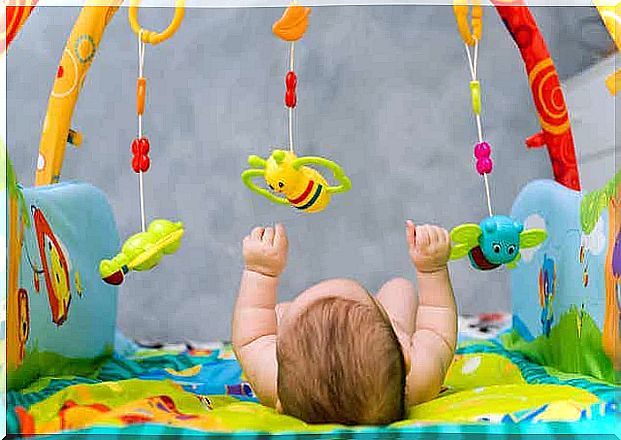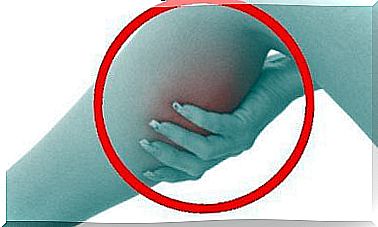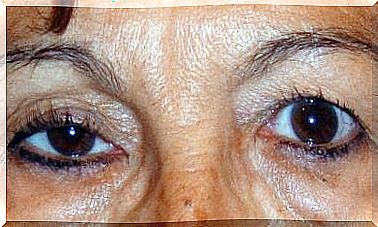How To Stimulate A Baby’s Eyesight

A baby’s vision is one of the least developed abilities at birth. That’s why encouraging it is so important. Children are born with difficulty focusing. After a few months of intensive learning, they are already doing very well, imitating movements, recognizing faces and interacting with others.
Babies are attracted to objects with a lot of contrast, round shapes, movements and voices. Early stimulation (link in spanish) provides security by helping them locate and recognize their caregivers.
Visual communication comforts them and creates bonding. Stimulation is undoubtedly necessary for reasons that we will explain later. In the first year, the pace of a child’s cognitive experiences is staggering.
What does a newborn’s vision look like?
Newborns are born with the right vision to cling to everything that is close by. In the foreground they see their mother looking at them, smiling and nursing from about 25 to 30 centimeters away. Farther away, their blurry vision doesn’t allow them to understand what’s going on around them, so they focus only on what’s close and vital.
A baby’s gaze at birth is on the mother, on the shape of her face, on the contrast of her eyes, on her high-pitched voice. This look is also focused on the darkened color of the areola. It is this first look that makes us parents.
Pediatrician Marc Pilliot calls it a ‘thorough look’ in the article ‘The look of the newborn’ (La consider du naissant). In other words, it is a bridge to life that has just begun.
Because of the dark warmth of the womb they left behind, babies do not like brightness. If they follow something with their eyes, they follow it sideways, not up and down. Plus, they look at the edges, not the center.
Tips to boost a baby’s eyesight

In general, we should not force children to perform any activity. They only learn by playing in an environment of harmony, joy and tranquility. If you notice that they are annoyed, it’s because they don’t enjoy what they are doing.
Early Stimulation
From the moment of pregnancy, the mother has a close and intimate relationship with her unborn child. The fetus hears mumbling and voices that it encounters again after birth. This is exciting for the baby. Numerous studies show that the prenatal relationship is crucial in the development of affection between the baby and the mother (Spanish link).
Indeed, from the moment the baby’s eyes open and the first exchange of glances that form the basis of the relationship between mother and child, it is possible to stimulate the baby’s visual ability. Fragrances and colours, plus the warmth and softness of the mother’s skin, prepare the baby for the instinctive adventure of existence.
Stimulating a baby’s visual ability to strengthen contact
The visual mother-child relationship is intense and will be the common thread of the other stimuli. The relationships that the eye establishes with objects will mobilize the hands and the body. Eye-hand coordination is structural and will determine the baby’s progress in neurodevelopment.
Besides, if the mother does not look at her baby at the time of breastfeeding, most babies will lean forward and try to re-establish contact. If they fail to do this, they will probably cry.
Encouraging Curiosity
There is no doubt that the engine of knowledge acquisition is curiosity. In children, it is what mobilizes the entire learning system. The environment that babies visualize, which is close by and in motion, leads the child to survival and protection.
Biologically, they are attracted to faces because they mainly focus on faces. Then they are attracted to luminous shapes that reproduce organic sequences and rhythms.
Attracting their curiosity, making them follow objects, making objects disappear and reappear are all part of training their ability to search and remember. These exercises are part of the field of neuroplasticity.
The Benefits of Stimulating a Baby’s Vision

Vision begins to focus after about three months and then increases until six months of age. Then it almost reaches the values of the adult visual field.
However, it is possible to stimulate a baby’s vision from birth. An important element in the stimulation is the early detection of vision problems. It is even possible to diagnose them before the age of one.
For example, in children under thirty days of age, it is possible to determine whether they fix their gaze on a particular moving object and follow it. The test will not be definitive until the third month of life. But if the baby cannot do this, you should take your baby to the specialist.
Finally, stimulation of vision leads to body awareness, which is the basis of spatial awareness. This, in turn, is based on auditory and tactile development and haptic information at birth.
Stimulating a baby’s eyesight: the sooner the better
By the 25th week of pregnancy , the fetus has a hundred billion neurons, but only a few are connected at the time of birth. It is then, from birth to the age of three, that they are integrated through networks and connections.
That’s why early stimulation with music therapy is so important from the womb to the age of six. It is essential to do exercises and games that develop their sensory, intellectual, motor, emotional and social development. Voices and sounds, caresses, colors and movements are also elements that generate nerve connections in their brains.
In short, sight is one of the senses that must be stimulated and developed as quickly as possible. Keep in mind that vision and its associated neurological circuitry develop in the first four months.









